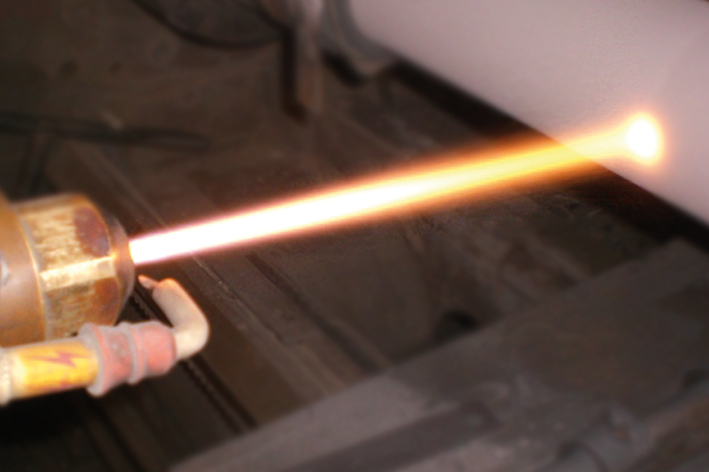» Solutions
Our technology is used wherever something rotates or moves.

We coat surfaces for equipment, machines and plant construction – for protecting against abrasion and corrosion and for improving friction values.
We repair and produce machine components such as drive shafts, axles, shaft sleeves or bolts, with or without coating. Our solutions serve the following industrial sectors:
- General machine and systems building
- Valve industry
- Chemical industry
- Petroleum and gas industry
- Compressor technology
- Power plants
- Plastics industry
- Mixing technology
- Food industry
- Paper industry
- Pump building
- Refineries
- Steel mills

Wire flame spraying
The spraywire is melted by a gas/oxygen flame, finely sprayed and applied to the surface of the workpiece in a pasty liquid condition. The fine spray particles solidify and bond to the pretreated surface.
This cost-effective process is used mainly for repair works. Here, for example, worn sealing or bearing parts can be put back into service with considerable time, material and cost savings when compared to producing an entirely new part. Using the appropriate wire materials often leads to extended lifetimes with respect to uncoated, original spare parts or the production of a new part.

Powder flame spraying
In this process a powder-type material is melted in a gas/oxygen flame, accelerated by the flame speed and in this way applied to the workpiece surface. The particles solidify and bond to the surface of the workpiece.
This technology is not only used for coating new parts, but also for carrying out repairs. High value, abrasion and corrosion-resistant materials of metallic or ceramic type can be processed in this manner.
For optimizing the coating, we also produce our own mixtures in-house to suit the specific needs of our customers.

High velocity flame spraying
With this thermal spraying technology, coatings of premium quality, density and hardness are produced. A wide variety of materials can be processed. A typical application for this process is metal carbide coating for extremely abrasive loads.
An oxygen-flammable gas mixture is ignited inside a combustion chamber, which has a nozzle that accelerates the rapidly expanding gas to supersonic speed.
Using an inert carrier gas, the powder-type coating material is fed into the process in a regulated manner and is also accelerated to a supersonic speed.
In addition to thermal energy, the sprayed particles also take on a great amount of kinetic energy, which gets converted into additional thermal energy when they strike the surface to be coated. This results in a high degree of spray particle deformation, which leads to well-bonded and extremely dense coatings.
With a hardness of well over 1000 HV, such coatings offer a wide variety of solutions for the problems of abrasion.

Electric arc spraying
Arc-spraying is characterized by its economy. High spray rates with relatively low energy consumption allow cost-saving repair coating in the event of damage from abrasion.
Two metallic wires are fed together by electrically-conducting wire guides at a regulated feeding speed. The spray material is completely melted by the short-circuit current. Using an atomizing gas, the melted material is converted into fine particles and shot onto the pretreated workpiece. Depending on the spray material, the particles reach speeds of up to 150 m/s. Another advantage is the low warming of the base material that is to be coated. Coating thicknesses of multiple millimeters can be reached. In addition to carbon-steels and high chrome steel alloys, filler wires with hard materials can be applied as well. Moreover, pseudo-alloys can be produced in this way by using two different wire materials. Depending on the composition, these can open up completely new possibilities for solving corrosion and abrasion problems. The superior properties of the two spray materials are unified.

Thermo spray process
Self-fluxing, powder-type, multiple-phase alloys, most of them based on a nickel compound, are first sprayed using a flame spraying process. They are melted onto the workpiece in an additional work step once the necessary thickness is reached. Diffusion of the coating material with the base material takes place via the melting process (at approx. 1100°C). Coatings of various hardness levels (up to approx. 62 HRC) can be produced. By mixing in additional hard materials such as tungsten-carbide or chromium-carbide, the hardness of these coatings can be elevated even more.
Because of the melting process, these coatings are airtight and characterized by their excellent resistance to abrasion and corrosion. Because of the high process temperatures during melting, such coatings make sense, especially for the production of new parts that will be subjected to heavy loading.
